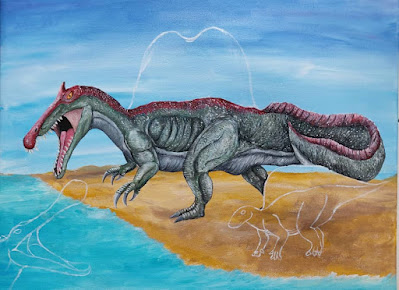Sovereign of the Sahara, acrylic on canvas, 2021. 24" X 18"
95 million years ago in the middle Cretaceous, the Sahara desert in North Africa was a completely different place. It was filled with patchworks of sandy deserts and fertile wetlands, where its water was sourced from the ocean. These wetlands became a suitable habitat for dinosaurs, including Spinosaurus, one of the largest carnivorous dinosaurs that had ever lived.
The overall appearance of Spinosaurus in illustrations had changed largely since its discovery in the Sahara desert in 1915. It was originally envisioned as a bipedal theropod with a large sail on its back. At the time, little was known about Spinosaurus' anatomy due to the original fossils being lost after the museum in Berlin, Germany where it was housed in was destroyed in World War II. In the middle 1990s, skull material of Spinosaurus was discovered in another part of the Sahara, confirming that the animal had a long snout like crocodilians and had a diet of fish. The reconstruction radically changed in 2014 as more fossils of Spinosaurus were discovered in a major find, which hints in the shrinking of the dinosaur's hind legs and a quadrupedal gait. More recently in 2020, discovery of tail vertebrae deduces that Spinosaurus was in fact mostly aquatic, with the flatter tail being shaped like a paddle to serve as a mode of propulsion while swimming underwater.

The evolution of Spinosaurus' reconstruction. Source: Natural History Museum UK
Pre-2014 reconstruction (left) compared with the more modern reconstruction (right)
Also featured in the painting is
Ouranosaurus (meaning "brave lizard"), a herbivorous ornithopod dinosaur discovered in the same area as
Spinosaurus. Like
Spinosaurus, it had a sail on its back comprised of extended spinous processes on its vertebrae. However, unlike that of
Spinosaurus', the sail of
Ouranosaurus is thicker, and its exact function is currently unknown. Some scientists believe that it used the sail as a heat radiator just like
Spinosaurus, while others proposed that the sail may have contained muscle or fat reserves to serve as energy storage which may have enabled the dinosaur to survive in hostile conditions.
The crocodilian in the painting is
Sarcosuchus (meaning "flesh crocodile"). Measuring up to 10 meters in length,
Sarcosuchus was one of the largest crocodiles that had ever existed. It primarily hunted herbivorous dinosaurs, and shared the waterways of the Cretaceous Sahara with
Spinosaurus.
The pterosaur in the top left of the painting is
Alanqa (meaning "phoenix" in Arabic). Its fossils were discovered in Morocco where
Spinosaurus lived, and it is one of the few pterosaurs known from North Africa. With a wingspan of almost 4 meters, it was more than twice the size of an eagle.
According to the artist, the clouds are shaped like ichthyosaurs, which may have symbolized that the time setting of the work had seen the decline of this marine reptile family before they completely disappeared around 93 million years ago.













Comments
Post a Comment